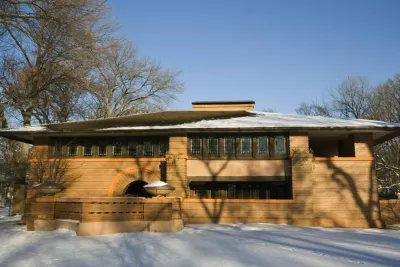In an extended discussion, Keith Eggener examines what it means for a work of architecture to be "naturally" American, and why looking at modern American styles through an intensively regional lens may be unhelpful.

Basing his essay on a Portland Art Museum exhibit showcasing the work of architect John Yeon, Keith Eggener delves deeply into American architectural identity, both national and regional.
Eggener traces the idea of distinctively American architecture through the early 20th century, a period when international styles interacted with homegrown sensibilities in the work of pioneers like Frank Lloyd Wright. "Just as a foreign-born person may become naturalized when moving to a new country, so foreign-born architectural themes were being naturalized through their adaptation to American conditions."
In the post WWII period, Eggener writes, America's international predominance solidified its architectural reputation as the font of all things modern. But a parallel narrative around "regionalist" forms also emerged, centered on the suburbs. "It's notable [...] that the new regionalist architecture of mid-century America was limited almost exclusively to a single building type: the free-standing, private house."
Eggener goes on, "So it seems reasonable to ask: why does so much so-called regional modern architecture across the U.S. look so much like architecture found in regions other than its own?" Regional variation exists, but there's also a lot of architectural uniformity across the U.S. As Yeon put it, "Whether there is or is not a Northwest regional style of architecture is debatable, but what is certain is that lot of people want to think there is."
FULL STORY: A Fortuitous Shadow

Planetizen Federal Action Tracker
A weekly monitor of how Trump’s orders and actions are impacting planners and planning in America.

Maui's Vacation Rental Debate Turns Ugly
Verbal attacks, misinformation campaigns and fistfights plague a high-stakes debate to convert thousands of vacation rentals into long-term housing.

San Francisco Suspends Traffic Calming Amidst Record Deaths
Citing “a challenging fiscal landscape,” the city will cease the program on the heels of 42 traffic deaths, including 24 pedestrians.

Amtrak Rolls Out New Orleans to Alabama “Mardi Gras” Train
The new service will operate morning and evening departures between Mobile and New Orleans.

The Subversive Car-Free Guide to Trump's Great American Road Trip
Car-free ways to access Chicagoland’s best tourist attractions.

San Antonio and Austin are Fusing Into one Massive Megaregion
The region spanning the two central Texas cities is growing fast, posing challenges for local infrastructure and water supplies.
Urban Design for Planners 1: Software Tools
This six-course series explores essential urban design concepts using open source software and equips planners with the tools they need to participate fully in the urban design process.
Planning for Universal Design
Learn the tools for implementing Universal Design in planning regulations.
Heyer Gruel & Associates PA
JM Goldson LLC
Custer County Colorado
City of Camden Redevelopment Agency
City of Astoria
Transportation Research & Education Center (TREC) at Portland State University
Jefferson Parish Government
Camden Redevelopment Agency
City of Claremont





























